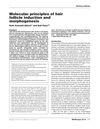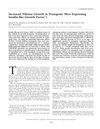Sgk3 Links Growth Factor Signaling to Maintenance of Progenitor Cells in the Hair Follicle
August 2005
in “
The Journal of Cell Biology
”
TLDR Sgk3 is essential for normal hair follicle growth and maintenance.
The study demonstrated that Sgk3, a kinase related to Akt, played a crucial role in the regulation of hair follicle cycles in mice. Mice lacking Sgk3 exhibited abnormal hair follicle maturation, with reduced proliferation, increased apoptosis, and premature regression of follicles. This was linked to impaired maintenance of transiently amplifying matrix cells. Interestingly, the absence of Sgk3 mimicked the effects of enhanced epidermal growth factor signaling. The research highlighted that Sgk3 negatively regulated phosphatidylinositol 3 kinase signaling, revealing its novel and significant function in managing the balance between cell life and death within hair follicles.


